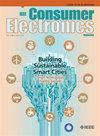A Simple Integration Architecture of Photovoltaic Plant for Consumer Electronics in LVDC Systems
IF 10.9
2区 计算机科学
Q1 ENGINEERING, ELECTRICAL & ELECTRONIC
引用次数: 0
Abstract
Low voltage direct current (LVDC) system with photovoltaic (PV) source typically contains multiple converters that are used to control the power flow from the PV array to DC loads leading to less end-to-end efficiency, control complexity, reliability issues, voltage regulation challenges, compactness issues, and increased system cost. In this paper, a new power flow architecture is designed for LVDC system that directly connects the PV array to consumer electronics (rated at 24 V) and employs only one front-end bidirectional DC-DC converter between the 24 V load line and the 48 V bus. The bi-directional converter manages load line voltage regulation through a 48 V bus. Under normal conditions, the PV array powers the load while seeking minimal support from the 48 V bus via bi-directional converter, while extensive power is drawn only when the PV output is insufficient for the load requirement, ensuring differential power processing. By introducing a unique power flow layout with a simple design and eliminating intermediate converters, this architecture offers superior end-to-end efficiency, simplified control, and greater reliability compared to previous solutions. To assess theoretical efficiency, a mathematical model of the proposed architecture is also developed. Simulation tests have been conducted, which validate the fundamentals of proposed architecture and indicate its efficiency over 95% under normal weather conditions. Moreover, the comparative analysis confirms the superior capability of proposed architecture over existing ones. Finally, the functionality of the proposed architecture is verified by experimental prototype.LVDC系统中消费类电子产品光伏电站的简单集成架构
具有光伏(PV)电源的低压直流(LVDC)系统通常包含多个转换器,用于控制从PV阵列到直流负载的功率流,导致端到端效率降低,控制复杂性,可靠性问题,电压调节挑战,紧凑性问题以及系统成本增加。本文为LVDC系统设计了一种新的潮流架构,该系统将光伏阵列直接连接到消费类电子产品(额定电压为24v),并且在24v负载线和48v总线之间仅使用一个前端双向DC-DC转换器。双向转换器通过48v总线管理负载线电压调节。在正常情况下,光伏阵列为负载供电,同时通过双向变换器寻求48v母线的最小支持,而只有在光伏输出不足以满足负载需求时才会大量供电,从而保证差分功率处理。通过引入具有简单设计和消除中间转换器的独特潮流布局,与以前的解决方案相比,该架构提供了卓越的端到端效率,简化的控制和更高的可靠性。为了评估理论效率,还开发了所提出的体系结构的数学模型。进行了仿真测试,验证了所提出的架构的基本原理,并表明其在正常天气条件下的效率超过95%。此外,对比分析证实了所提体系结构优于现有体系结构的性能。最后,通过实验样机验证了所提架构的功能。
本文章由计算机程序翻译,如有差异,请以英文原文为准。
求助全文
约1分钟内获得全文
求助全文
来源期刊
CiteScore
7.70
自引率
9.30%
发文量
59
审稿时长
3.3 months
期刊介绍:
The main focus for the IEEE Transactions on Consumer Electronics is the engineering and research aspects of the theory, design, construction, manufacture or end use of mass market electronics, systems, software and services for consumers.

 求助内容:
求助内容: 应助结果提醒方式:
应助结果提醒方式:


